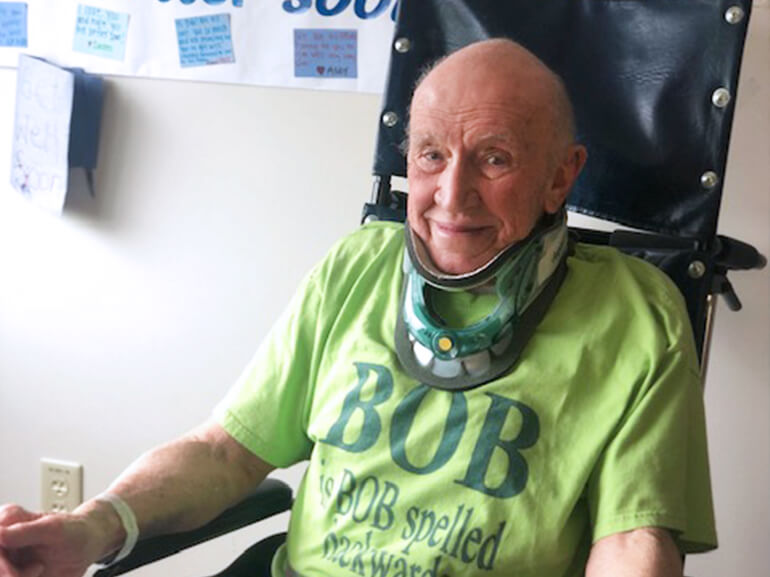Bob's story

Robert (Bob) Ostendorf, 85, has been married to his wife, Joan, for 37 years. Together they have three sons, two daughters, 12 grandchildren and four great-grandchildren. Prior to retiring, Bob ran a distribution center out of Cincinnati that delivered groceries, candy, tobacco and health and beauty products to stores and gas stations. In their free time, Bob and Joan like to bowl, play cards and watch their grandchildren play sports. Bob also worked part-time to keep himself busy.
Unfortunately, Bob’s active lifestyle was affected when he started having trouble raising his arms and experiencing pain in his back. In April, he went to the doctor for an MRI which showed the C1 and C2 vertebrae pressing against his spine. He had two choices: have surgery or do nothing. If he did nothing, he knew there was a chance he could end up paralyzed. Bob was also under the care of a cardiologist due to atrial fibrillation, or abnormal heartbeat. Prior to the onset of his latest symptoms, he was scheduled to receive a pacemaker. So, he consulted with his cardiologist who recommended he have surgery on his spine first and delay getting the pacemaker. That’s what Bob chose to do.
Bob had his surgery done at Bethesda North Hospital, which proved successful. However, he needed additional rehabilitation to get back to his prior level of independence. “I could hardly walk or even get myself up out of a chair,” said Bob. “I couldn’t use my hands to eat very well, and it was very difficult to hold a fork to eat. My wife even had to help me get dressed.” Bob transferred to TriHealth Rehabilitation Hospital to continue his recovery with a goal of being able to walk, feed and dress himself and get back to “as normal of a life as possible.”
In physical therapy, he started by standing and taking a few assisted steps in the parallel bars. He also used the LiteGait, a body weight support system, which provided the extra support Bob needed while he regained his strength. Bob was afraid of falling, and the LiteGait provided him with security knowing he was strapped into a harness. With enough practice in the LiteGait, Bob gained the strength to progress to a rolling walker. “I was able to take long walks, with breaks, using my rolling walker.” Bob also progressed to being able to go up and down four steps.
Occupational therapists focused on helping Bob become independent in self-care tasks. He had difficulty using his hands, so they focused on exercises to strengthen his fingers such as putting puzzle pieces together and working with therapy putty, sponges and clothespins. As the use of his hands improved, Bob started using adaptive equipment while practicing daily living activities such as grooming, feeding, dressing and toileting. Each day brought more independence. “I was able to use my hands more, and I could use adaptive equipment to dress myself because I learned how to use a reacher and a dressing stick,” said Bob.
Bob praised his family for their support during his recovery. “My family’s support has been tremendous. There are so many signs and cards in my room that are a big boost.” His wife, daughter and daughter-in-law also attended family training so they would have all the knowledge and tools to assist Bob upon discharge.
After three weeks, Bob was ready to head home. He was looking forward to being back in his own house and spending lots of time with family. However, there were a few things Bob said he would miss about the hospital. “I’m going to miss the good food here.” He also noted he would miss the staff. “You feel like you’re important here and not just a number because everyone always is asking if they can do anything else for you before they leave your room.”